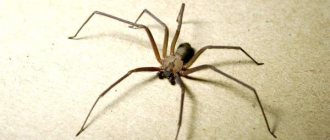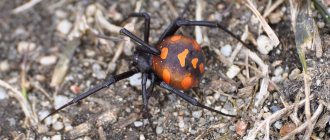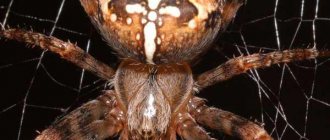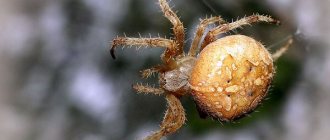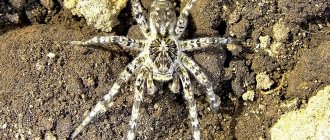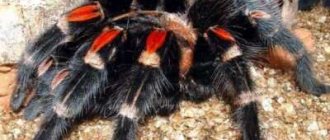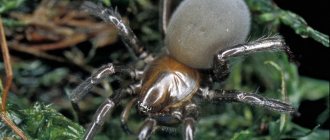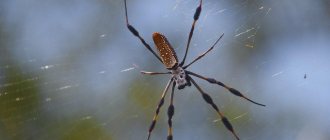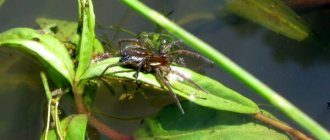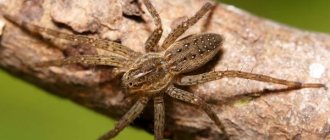The karakurt spider is one of the most dangerous creatures on earth. Despite its small size and non-threatening appearance, the karakurt's venom is 15 times stronger than that of a rattlesnake and 50 times stronger than that of a tarantula. For a horse or camel, a karakurt bite is often fatal.
The karakurt spider is one of the most dangerous creatures on earth
Without prompt medical intervention and professional help, a meeting with a person can also result in death, although such cases are extremely rare. The black spider evokes mystical associations due to the presence of 13 bright red spots on the body and cannibal family traditions. Kalmyk shamans use a dangerous creature in some rituals. There is a common belief that karakurts live only in deserts and do not pose a danger to residents of the central and even southern steppe and forest regions, but this is not true. Recently, the migration of biting “robbers” to the north has been obvious, and climate warming has led to the fact that karakurts are recorded in regions where they have never been observed before.
Description and life activity of karakurt
The poisonous karakurt spider belongs to the order of spiders of the family of web spiders from the genus of black widows. Translated from the Turkic language, the name is literally translated as a black worm. The Latin name Latrodectus tredecimguttatus reflects the external characteristics - 13 points on the back and the essence of the spider (biting robber). What does the karakurt spider, which is sometimes called the steppe spider, look like? In terms of size, the spider belongs to the medium arachnids. The size of the male is 4-7 mm, the female karakurt is 2-3 times larger and can reach 20 mm. The body of the eight-legged spider is black, with a pronounced abdomen. Both males and females have red spots or dots on the upper side of the abdomen. On the lower part of the abdomen a clear scarlet pattern is visible, similar to the outline of an hourglass. The spot on the abdomen often has a snow-white halo. Adults (males) can be completely black. Karakurt is a predator; it feeds on insects, which it uses a web to catch.
Despite its small size and non-threatening appearance, the karakurt's venom is 15 times stronger than that of a rattlesnake and 50 times stronger than that of a tarantula.
White karakurt, also related to web spiders, has a white or yellowish color. There is no hourglass pattern or spots on the body, but there are 4 indentations forming a rectangle. White spiders are much less poisonous, their bite is not dangerous to people, although the venom of the white karakurt is similar in its toxicological properties and effects on the human body and animals to the venom of the black widow. White karakurts can be found in Russia and neighboring countries, but the main habitat is located further south - in North Africa, the Middle East, and also in Central Asia. Let's focus on the black widow karakurt as the most dangerous representative of the swindlers, which you can meet at domestic resorts.
Lifestyle
The spider is engaged in weaving a strong web, which has a hole in the middle. Usually the arthropod places it on an inclined surface among minor vegetation.
Are you afraid of spiders?
TerribleNo
However, the paikulla steatoda can also hunt on the ground. This is typical of spiders that live in semi-deserts.
They are capable of attacking prey that is larger than them. They are capable of neutralizing and eating even a black widow.
Spiders have trouble seeing. They recognize their prey by vibrations in the web. Steatoda is not aggressive. Can attack a person only if life is threatened. Life expectancy does not exceed 6 years.
Gallery: karakurt spider (25 photos)
Chinese tarantula
This spider is classified as one of the varieties of the large tarantula. The length of its body is about twenty centimeters. You can meet arthropods of this species in Vietnam and China. Due to their inherent size and ferocious appearance, locals call these spiders earth tigers.
The venom of the Chinese tarantula has been studied in laboratory conditions. Experimental results have proven that toxic substances released by these arthropods lead to the death of small mammals in fifty percent of cases.
Habitat and biological enemies
The zone of residence of the Karakurts covers the Crimea, southern Russia and Ukraine, the Astrakhan steppes, Kazakhstan, Central Asia, the Middle East and North Africa. When migrating north, spiders reach the Saratov region, the Southern Urals and even the Moscow region, but they cannot settle in the northern regions; in winter the spiders die. For living, karakurts choose dry steppe areas and arable lands, wastelands, salt marshes, slopes of ravines, ditches, ruins of abandoned villages, cracks in adobe houses. The spider can also be found in populated areas, in summer cottages, and sometimes it penetrates into a person’s home. The peak of activity occurs during the fertilization period - June-August.
Spider Hunting Rules
For an argiope waiting for prey, it is not enough to simply weave a net. The owner of the trap sits in its center, in that very zigzag segment, and waits for the victim, holding a skein of created threads in his limbs. When the prey is caught, the hunter entangles it in a web and bites it. The insect dies from the poison; at the same time, it begins to be partially digested, while not yet in the spider’s mandibles.
Danger to humans
As a rule, males and young individuals do not pose a danger to humans, since they cannot bite through the skin with their weak jaws, although isolated cases of attacks are known. Adult females pose a danger, especially in July-August. You can distinguish the female by its color. Males have red spots with white rims, while females have no edging. Sometimes in females the red spots change to yellow stripes. Females have long legs up to 30 mm and are significantly larger than males.
The attack happens very quickly. Karakurt attacks only in self-defense. Nature has endowed the spider with such a strong poison so that it can capture the burrows of small rodents, which do not come into conflict with it and immediately vacate their territory. A predator can attack when it first seems to be in danger, so it is better to avoid contact with it. The difficulty in detecting danger lies in the fact that karakurts do not weave their net in the classical way. The threads are arranged horizontally, the web does not have a characteristic pattern and is chaotic. Attacks occur most often at night and on vacation, when you can accidentally crush the karakurt or disturb the web.
A spider bite is not painless, but it does not cause much concern. The bite site is marked with a small red spot, which disappears after a few minutes. After the poison has taken effect, the bitten person begins to experience severe pain in the damaged area. Specific psychological and physiological reactions arise.
In the first minutes and hours after the bite, poisoning is characterized by the following symptoms:
- strong mental agitation;
- feeling of fear of death, panic;
- spasms and suffocation;
- severe pain in the abdomen, chest and lower back;
- feeling that the legs are being taken away;
- bluish complexion;
- shallow breathing, dizziness;
- sometimes cramps of the arms and legs, tremors, vomiting;
- increased heart rate, arrhythmia;
- retention of urination and defecation;
- increased protein content in urine.
Sad breeding
Spiders of the species Argiope Brünnich deal with the issue of leaving offspring during the molting period, when the female has already shed the previous chitin, but has not yet acquired new ones. After the male has done his job, the female in the vast majority of cases eats him. Sometimes the “brave fellow” manages to impregnate the second lady, but, according to scientists, not a single one lived to see the third approach. There is a theory that the cannibalism of spiders is caused by a lack of protein necessary for the development of heirs. However, you shouldn’t sympathize too much with their “men”: the female Argiope does not survive her “husband” for long. After creating cocoons and laying eggs in them (up to 400 eggs in each “little jar”), the wasp spider dies. The offspring spend the winter in the houses she created, and in the spring they emerge from them completely independently.
Treatment and prevention
The most elementary and well-known since ancient times method of treating a poisonous spider bite, supported by official medicine, is cauterization. The predator's venom is sensitive to heat and is destroyed when heated, losing its toxic properties. Therefore, immediately, within 2 minutes after the attack, the damaged area must be burned with a cigarette, match or other method. The spider does not have powerful jaws, the bite depth does not exceed 0.5 mm, so immediate cauterization has a strong effect. In any case, you should contact a medical facility as soon as possible.
As special measures, anti-caracourt serum is used, which is administered intramuscularly. The serum relieves the main symptoms of poisoning, and recovery time is reduced to 3-4 days.
The disadvantage of this product is its high cost. In the absence of a special substance, the following is administered intravenously:
- novocaine;
- calcium chloride;
- magnesium hydrogen sulfate.
- 33% ethyl alcohol;
- 2-3% solution of potassium permanganate.
The victim must be given water, rubbed with alcohol, and enemas are recommended. Universal remedies can be used as painkillers: Analgin, Diphenhydramine, Ketanol.
In cases of living in the territory inhabited by karakurts, it is necessary to be careful when cleaning residential premises, especially in adobe houses, and pay attention to the presence of cobwebs in personal areas. When going outdoors, you should follow certain rules:
- do not spend the night in the open air in habitats of poisonous spiders;
- do not come into contact with the inside of the tents;
- examine the place where you spend the night or rest, paying attention to holes and natural depressions in the ground, rodent burrows, and if there are any, cover them with earth;
- use covering clothing and wear a hat;
- periodically, and without fail before going to bed, carefully inspect the tent, sleeping places, clothes, shoes and other property;
- use the canopy, tucking it under the sleeping place;
- dig around the tent, making a shallow ditch;
- do not take off your shoes;
- If you find a karakurt, do not touch it; if the spider is on your clothes, shake it off or knock it down with a click.
To prevent the death of domestic animals, the soil is treated with hexachlorane and other poisons.
Tarantula
Tarantulas are a genus of spiders from the wolf spider family. These are large poisonous spiders, averaging 10 cm in size. Tarantulas live in steppes, deserts and semi-deserts.
The main time of activity and hunting is after sunset. The spider does not weave hunting nets, so a poisonous bite is the only way to hunt. Most often, tarantulas feed on large insects.
Tarantula: Wikipedia
A tarantula bite is not fatal to a healthy adult, but does cause swelling. If a tarantula attacks, consult a doctor. This type of spider can easily be confused with the more dangerous larger spiders.
The Tarantella dance is named after tarantulas: it was believed that only energetic dance movements could save a person from the serious consequences of an arthropod bite.
Leave your details
We will contact you shortly
Hawk repeller OC-3
Ultrasonic dog repeller Yastreb OS.03
Designed to protect against stray dogs. The device is equipped with a gentle mode for training your pet. This device does not have a deterrent effect on special-purpose dogs, fighting or trained dogs.
Upper position (“?”): Turns on the flashlight. The LEDs installed in this device are very bright and have an additional effect on dogs, and can also be used as a flashlight.
Middle position (“I”): in this position, the device emits a weaker signal, using it you can attract the attention of your dog for training.
Bottom position (“II”): the position when the device is in repellent mode (the device will automatically begin to emit ultrasound and light).
The sound is perceived by the dog at a distance of 5-25 m, the most effective distance is 4-8 m. The sound does not harm the dog’s psyche.
| Range | 25m |
| Radiated frequency range | 20–30kHz |
| Pressure at a distance of 1m | ≥120dB |
| Dimensions | 48x48x150mm |
| Weight without batteries | ≤70g |
| Operating temperature range | -5– +40°С |
| Battery type | 6F22 9 V "Krona" |
Hawk 500
Sak
What are the most dangerous spiders in tenth place in the presented ranking? These arthropods are called golden or golden ones. We are talking about yellow saka spiders, which live mainly in Europe. This small (up to 1 cm in length) arthropod builds itself a bag-like shelter. Sometimes sakis simply sit out inside their house. The bites of these spiders are clinically dangerous and cause extensive tissue necrosis. However, fortunately, golden sakis are not at all aggressive. They can attack people only when there is a feeling of danger.
